机械工程导论Ch1-The mechniacal Engineering Profession
- 格式:pdf
- 大小:767.93 KB
- 文档页数:34
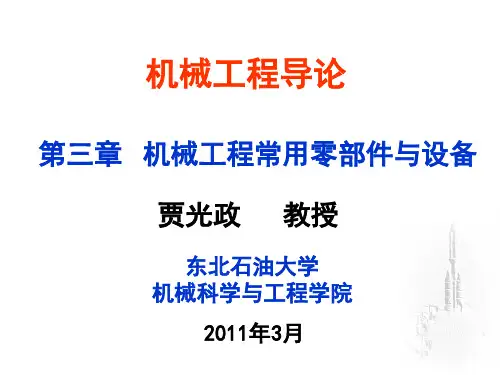
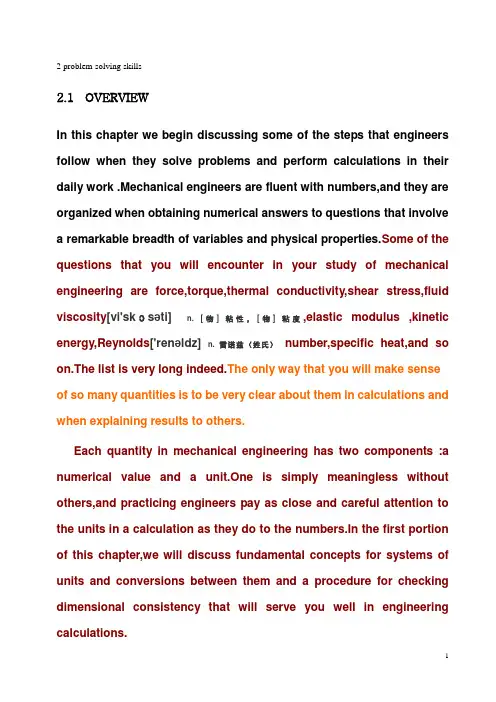
2 problem-solving skills2.1 OVERVIEWIn this chapter we begin discussing some of the steps that engineers follow when they solve problems and perform calculations in their daily work .Mechanical engineers are fluent with numbers,and they are organized when obtaining numerical answers to questions that involve a remarkable breadth of variables and physical properties.Some of the questions that you will encounter in your study of mechanical engineering are force,torque,thermal conductivity,shear stress,fluid viscosity[vi'skɔsəti] n. [物] 粘性,[物] 粘度,elastic modulus ,kinetic energy,Reynolds['renəldz] n. 雷诺兹(姓氏)number,specific heat,and so on.The list is very long indeed.The only way that you will make sense of so many quantities is to be very clear about them in calculations and when explaining results to others.Each quantity in mechanical engineering has two components :a numerical value and a unit.One is simply meaningless without others,and practicing engineers pay as close and careful attention to the units in a calculation as they do to the numbers.In the first portion of this chapter,we will discuss fundamental concepts for systems of units and conversions between them and a procedure for checking dimensional consistency that will serve you well in engineering calculations.Aside from the question of units,engineers must obtain numerical answers to questions- how strong ?how heavy?how much power?what temperature?—often in the face of uncertainty and incomplete information.At the start of a new design,for instance,the shape and dimensions of the final product are not known ;if they were ,then it wouldn,t be necessary to design in the first place .Only rough estimates of the force applied to a structure might be available.Likewise,exact values for material properties are rarely known,and there will always be some variation between samples of materials.Nevertheless,an engineer still has a job to do,and the design process must start somewhere.For that reason,engineer make approximations in order to assign numerical values to quantities that are otherwise unknown. Those approximations are understood to be imperfect,but they are better than random guesses and certainly better than nothing.Mechanical engineer use their common sense,experience,intuition,judgment,and physical laws to find answers through a process called order-of-magnitude approximation.These estimates are a first step toward reducing a concrete physical situation to its most essential and relevant pieces.Mechanical engineers are comfortable making reasoned approximations.In the following sections we begin a discussion of numerical values,unit systems,significant digits,and approximation.These principles and techniques will be applied further as we explore the"element"of mechanical engineering outlined in later chapter. After completing this chapter,you should be able to:● Report both a numerical value and its units in each calculationthat you perform.● List the base units in the United States Customary System andthe Systeme International d'unites,and state some of the derived units used in mechanical engineering.● Understand the need for proper bookkeeping of units whenmaking engineering calculations and the implications of not doing so.●Convert numerical quantities from the United States CustomarySystem to the Systeme International d'Unites,and vice versa.● Check your equations and calculations to verify that they aredimensionally consistent.● Understand how to perform order-of-magnitude approximations. 第二章解决问题的技能2.1概述这一章,我们开始探讨机械工程师在日常工作中,解决问题、进行计算时所采用的步骤。
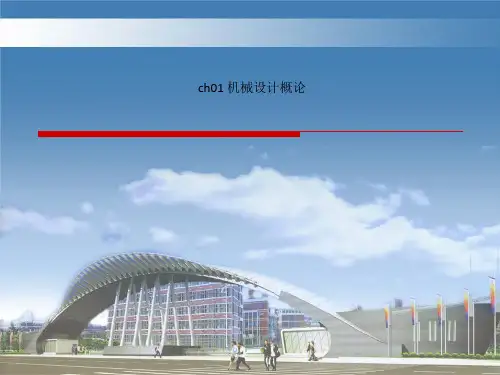
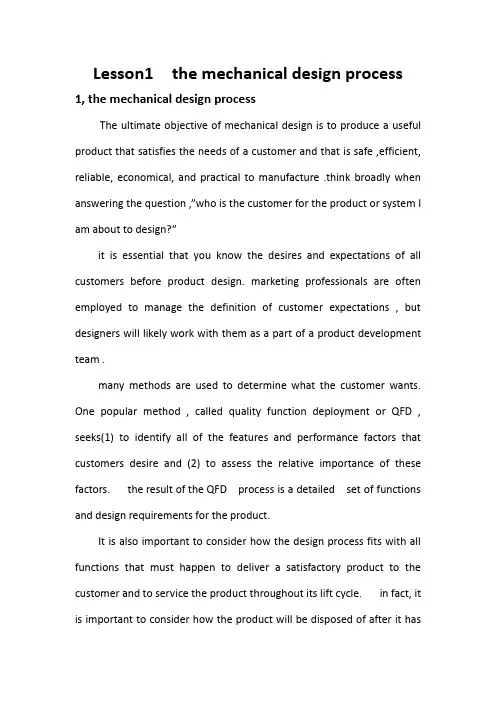
Lesson1 the mechanical design process 1, the mechanical design processThe ultimate objective of mechanical design is to produce a useful product that satisfies the needs of a customer and that is safe ,efficient, reliable, economical, and practical to manufacture .think broadly when answering the question ,”who is the customer for the product or system I am about to design?”it is essential that you know the desires and expectations of all customers before product design. marketing professionals are often employed to manage the definition of customer expectations , but designers will likely work with them as a part of a product development team .many methods are used to determine what the customer wants. One popular method , called quality function deployment or QFD , seeks(1) to identify all of the features and performance factors that customers desire and (2) to assess the relative importance of these factors. the result of the QFD process is a detailed set of functions and design requirements for the product.It is also important to consider how the design process fits with all functions that must happen to deliver a satisfactory product to the customer and to service the product throughout its lift cycle. in fact, it is important to consider how the product will be disposed of after it hasserved its useful life . the total of all such function that affect the product is sometimes called the product realization process or PRP . some of the factors included in PRP are as follows:1 marketing functions to assess customer requirements2 research to determine the available technology that can reasonably be used in the product3 availability of materials and components that can be incorporated into the product4 product design and development5 performance testing6 documentation of the design7 vendor relationships and purchasing functions8 work-force skills9 physical plant and facilities available10 capability of manufacturing systems11production planning and control of production systems12production support systems and personnel13 quality systems requirements14 sales operations and time schedules15 cost targets and other competitive issues16 customer service requirements17 environmental concerns during manufacture , operation anddisposal of the product18 legal requirements19 availability of financial capitalCan you add to this list? You should be able to see that the design of a product is but one part of a comprehensive process. in this text, we will focus more carefully on the design process itself , but the producibility of designs must always be considered . this simultaneous consideration of product design and manufacturing process design is often called concurrent engineering.2 skills needed in mechanical designProduct engineers and mechanical designers use a wide range of skills and knowledge in their daily work . these skills and knowledge are included in the following :1sketching, technical drawing , and computer-aided design2 properties of materials, materials processing, and manufacturing processes3 applications of chemistry, such as corrosion protection, plating , and painting4 statics, dynamics, strength of materials , kinematics, and mechanisms5 fluid mechanics, thermodynamics, and heat transfer6 fluid power, the fundamentals of electrical phenomena, andindustrial controls7 experimental design and performance testing of materials and mechanical systems8 stress analysis9 specialized knowledge of the behavior of machine elements, such as gears, belt drives, chain drives, shafts, bearings, keys, splines, couplings, seals, spring, connections(bolted, riveted, welded, adhesive), electric motors, linear motion devices, clutches, and brakes10 creativity , problem solving ,and project management11 oral communication, listening, technical writing, and teamwork skills3 functions , design requirements and evaluation criteriaSection 1 emphasized the importance of carefully identifying the needs and expectations of the customer prior to beginning the design of a mechanical device. you can formulate these by producing clear , complete statements of functions, design requirements , and evaluation criteria:1 Functions tell us what the device must do , using general , nonquantitative statements that employ action phrases such as “to support a load”, “to lift a crate ”, “to transmit power”, or “to hold two structural members together”, etc2 Design requirements are detailed, usually quantitativestatements of expected performance levels, environmental conditions in which the device must operate, limitations on space or weight , or available materials and components that may be used3 Evaluation criteria are statements of desirable qualitative characteristics of a design that assist the designer in deciding which alternative design is optimum-that is , the design that maximizes benefits while minimizing disadvantagesTogether these elements can be called the specifications for the designMost designs progress through a cycle of activities are outlined in figure1.1. you should typically propose more than one possible alternative design concept. This is where creativity is exercised to produce truly novel designs .Each design concept must satisfy the functions and design requirements . a critical evaluation of the desirable features, advantages, and disadvantages of each design concept should be completed . then a rational decision analysis technique should use the evaluation criteria to decide which design concept is the optimum and , therefore , should be produced.Reading materialMechanical design is the process of designing and/or selecting mechanical components and putting them together to accomplish a desired function. Of course machine elements must be compatible ,must fit well together , and must perform safely and efficiently. The designer must consider not only the performance of the element being designed at a given time , but also the elements with which it must interface.To illustrate how the design of machine elements must be integrated with a larger mechanical design , let us consider the design of a speed reducer for the small tractor . suppose that,to accomplish the speed reduction ,you decide to design a double-reduction, spur gear speed reducer. You specify four gears , three shafts , six bearings, and a housing to hold the individual elements in proper relation to each other. The primary elements of the speed reducer are :1 the input shaft is to be connected to the power source, a gasoline engine whose output shaft rotates at 2000 rpm . a flexible coupling is to be employed to minimize difficulties with alignment .2 the first pair of gears, a and b ,causes a reduction in the speed of the intermediate shaft proportional to the ratio of the numbers of teeth in the gears. Gear b and c are both mounted to intermediate shaft and rotate at the same speed .3 a key is used at the interface between the hub of each gear and the shaft on which it is mounted to transmit torque between the gear and the shaft .4 the second pair of gears , c and d ,further reduces the speed of gear d and the output shaft to the range of 290 rpm to 295 rpm .5 the output shaft is to carry a chain sprocket.the chain drive ultimately is to be connected to the drive wheel of the tractor.6 each of the three shafts is supported by two ball bearings .making them statically determinate and allowing the analysis of forces and stresses using standard principles of mechanics.7 the bearings are held in a housing that is to be attached to the frame of the tractor . note the manner of holding each bearing so that the inner race rotates with the shaft while the outer race is held stationary.8 seals are on the input and output shafts to prohibit contaminants from entering the housing .9 details of how the active elements are to be installed , lubricated, and aligned are only suggested at this stage of the design process to demonstrate feasibility .one possible assembly process could be as follows.Start by placing the gearing the gears, keys, spacers, and bearings on their respective shaftsThen insert input shaft into its bearing seat on the left side of the housing.Insert the left end of intermediate shaft into its bearing seat whileengaging the teeth of gears a and b.Install the center bearing support to provide support for the bearing at the right side of input shaft.Install output shaft by placing its left bearing into the seat on the center bearing support while engaging gears c and d.Install the right side cover for the housing while placing the final two bearings in their seats.Ensure careful alignment of the shafts.Place gear lubricant in the lower part of housing .The arrangement of the gears, the placement of the bearings so that they straddle the gears , and the general configuration of the housing are also design decisions . the design process cannot rationally proceed until these kinds of decisions are made . when the overall design is conceptualized, the design of the individual machine elements in the speed reducer can proceed . you should recognize that you have already made many design decisions by rendering such a sketch . first, you choose spur gears rather than helical gears , a worm and worm gear , or bevel gears. in fact , other types of speed reduction devices –belt drives , chain drives, or many others—could be appreciate.1gearsfor the gear pairs ,you must specify the number of teeth in each gear ,the pitch (size) of the teeth , the pitch diameters, the face width ,and the material and its heat treatment . these specifications depend on considerations of strength and wear of the gear teeth and the motion requirements(kinematics ). You must also recognize that the gears must be mounted on shafts in a manner that ensures proper location of the gears, adequate torque transmitting capability from the gears to the shafts (as through keys ) and safe shaft design.2shaftshaving designed the gear pairs, next you will consider the shaft design . the shaft is loaded in bending and torsion because of the forces acting at the gear teeth . thus, its design must consider strength and rigidity , and it must permit the mounting of the gears and bearings . shafts of varying diameters may be used to provide shoulders against which to seat the gears and bearings. There may be keyseats cut into the shaft, the input and output shafts will extend beyond the housing to permit coupling with the engine and the drive axle . the type of coupling must be considered, as it can have a dramatic effect on the shaft stress analysis. Seals on the input and output shafts protect internal components.3bearingsdesign of the bearings is next. If rolling contact bearings are to be used , you will probably select commercially available bearings from a manufacturer’s catalog , rather than design a unique one . you mustfirst determine the magnitude of the loads on each bearing from the shaft analysis and the gear designs. The rotational speed and reasonable design life of the bearings and their compatibility with the shaft on which they are to be mounted must also be considered. For example , on the basis of the shaft analysis, you could specify the minimum allowable diameter at each bearing seat location to ensure safe stress levels . the bearing selected to support a particular part of the shaft ,then , must have a bore( inside diameter) no smaller than necessary. When a specific bearing is selected , the shaft at the bearing seat location and allowable tolerances must be specified ,according to the bearing manufacturer’s recommendations , to achieve proper operation and life expectancy of the bearing.。

第一章:机械工程及学科总论机械工程机械工程是以有关的自然科学和技术科学为理论基础,结合生产实践中的技术经验,研究和解决在开发、设计、制造、安装、运用和修理各种机械中的全部理论和实际问题的应用学科。
其基本构成是零件和机构,最终产品是机器。
机械就是机器和机构的总称。
2机械的组成(1)原动部分,是机械的动力源,机械依赖其驱动其他部分,如电动机、内燃机等。
(2)传动部分,是将原动部分的运动和动力传递给执行部分的中间装置,常由凸轮机构、齿轮机构等组成。
(3)控制部分,是控制机械的原动部分、执行部分和传动部分按一定的顺序和规律运动的装置,它包括各种控制机构、电气装置、计算机和液压系统等。
(4)执行部分,是直接完成机器预订功能的工作部分,如汽车的车轮、机床的主轴等。
机器是由若干不同零件组装而成:零件是组成机器的基本要素,即机器的最小制造单元。
各种机器经常用到的零件称为通用零件,如螺钉、螺母、轴、齿轮、弹簧等。
在特定的机器中用到的零件称为专用零件,如汽轮机中的叶片、起重机的吊钩、内燃机中的曲轴、连杆、活塞等。
构件是机器的运动单元,一般由若干个零件刚性联接而成,也可以是单一的零件。
机器的特征:1.都是由许多构件组合而成。
2.组成机器的各运动实体之间有确定的相对运动关系。
3.能实现能量的转换,代替或减轻人的劳动,完成有用的机械功。
凡具备上述三个特征的实体组合体称为机器。
机器组成完整的机器由原动机、工作机和传动装置三部分组成:原动机:机器的动力来源。
电动机、内燃机及液压机等。
工作机:处于整个机械传动路线终端,是完成工作任务的部分。
传动装置:主要作用是把动力部分的运动和动力传递给工作部分的中间环节。
6什么是机构:具有确定相对运动的各种实物的组合,即符合机器的前两个特征。
机构的特征:1.都是由许多构件组合而成。
2.组成机器的各运动实体之间有确定的相对运动关系。
机器与机构的区别:机构主要用来传递和变换运动,而机器主要用来传递和变换能量,从结构和运动学的角度分析,机器与机构之间并无区别。
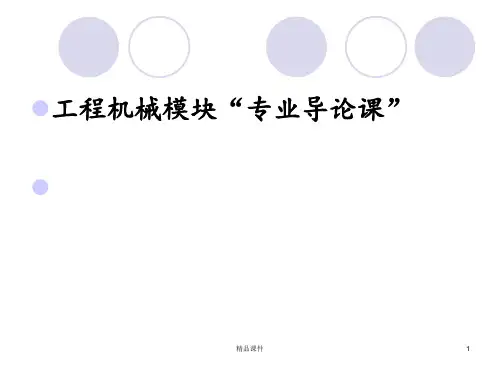
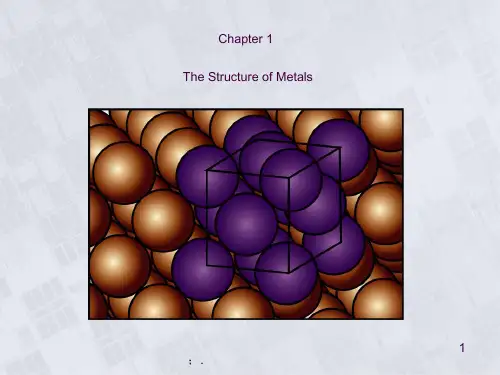
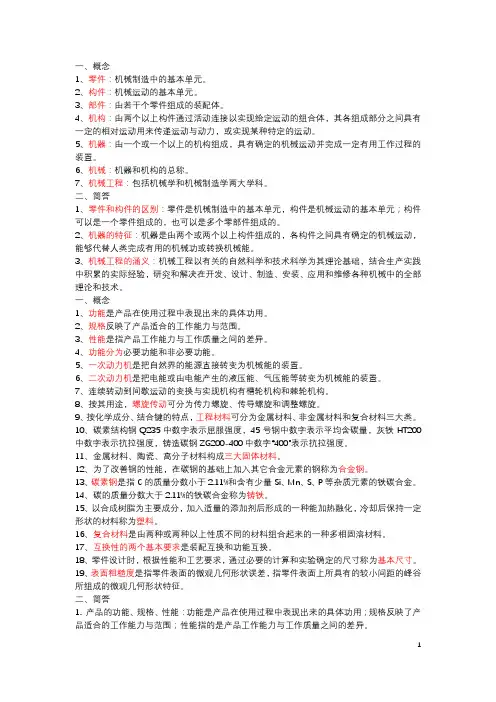
一、概念1、零件:机械制造中的基本单元。
2、构件:机械运动的基本单元。
3、部件:由若干个零件组成的装配体。
4、机构:由两个以上构件通过活动连接以实现给定运动的组合体,其各组成部分之间具有一定的相对运动用来传递运动与动力,或实现某种特定的运动。
5、机器:由一个或一个以上的机构组成,具有确定的机械运动并完成一定有用工作过程的装置。
6、机械:机器和机构的总称。
7、机械工程:包括机械学和机械制造学两大学科。
二、简答1、零件和构件的区别:零件是机械制造中的基本单元,构件是机械运动的基本单元;构件可以是一个零件组成的,也可以是多个零部件组成的。
2、机器的特征:机器是由两个或两个以上构件组成的,各构件之间具有确定的机械运动,能够代替人类完成有用的机械功或转换机械能。
3、机械工程的涵义:机械工程以有关的自然科学和技术科学为其理论基础,结合生产实践中积累的实际经验,研究和解决在开发、设计、制造、安装、应用和维修各种机械中的全部理论和技术。
一、概念1、功能是产品在使用过程中表现出来的具体功用。
2、规格反映了产品适合的工作能力与范围。
3、性能是指产品工作能力与工作质量之间的差异。
4、功能分为必要功能和非必要功能。
5、一次动力机是把自然界的能源直接转变为机械能的装置。
6、二次动力机是把电能或由电能产生的液压能、气压能等转变为机械能的装置。
7、连续转动到间歇运动的变换与实现机构有槽轮机构和棘轮机构。
8、按其用途,螺旋传动可分为传力螺旋、传导螺旋和调整螺旋。
9、按化学成分、结合键的特点,工程材料可分为金属材料、非金属材料和复合材料三大类。
10、碳素结构钢Q235中数字表示屈服强度,45号钢中数字表示平均含碳量,灰铁HT200中数字表示抗拉强度,铸造碳钢ZG200-400中数字“400”表示抗拉强度。
11、金属材料、陶瓷、高分子材料构成三大固体材料。
12、为了改善钢的性能,在碳钢的基础上加入其它合金元素的钢称为合金钢。
13、碳素钢是指C的质量分数小于2.11%和含有少量Si、Mn、S、P等杂质元素的铁碳合金。
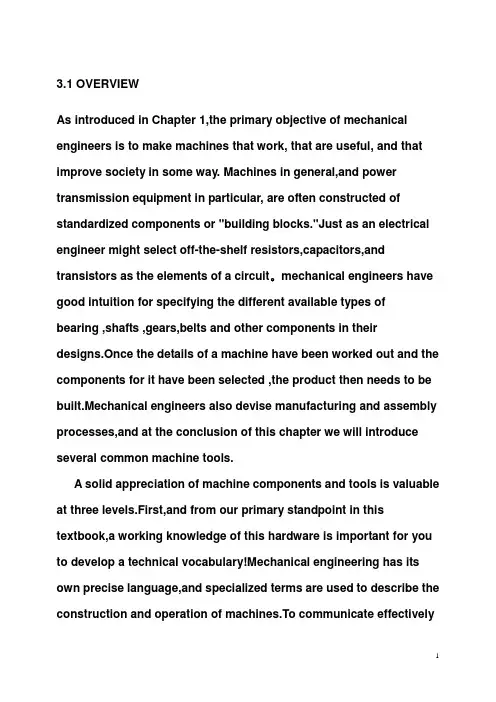
3.1 OVERVIEWAs introduced in Chapter 1,the primary objective of mechanical engineers is to make machines that work, that are useful, and that improve society in some way. Machines in general,and power transmission equipment in particular, are often constructed of standardized components or "building blocks."Just as an electrical engineer might select off-the-shelf resistors,capacitors,and transistors as the elements of a circuit。
mechanical engineers have good intuition for specifying the different available types ofbearing ,shafts ,gears,belts and other components in theirdesigns.Once the details of a machine have been worked out and the components for it have been selected ,the product then needs to be built.Mechanical engineers also devise manufacturing and assembly processes,and at the conclusion of this chapter we will introduce several common machine tools.A solid appreciation of machine components and tools is valuable at three levels.First,and from our primary standpoint in this textbook,a working knowledge of this hardware is important for you to develop a technical vocabulary!Mechanical engineering has its own precise language,and specialized terms are used to describe the construction and operation of machines.To communicate effectivelywith other engineers,you will need to learn,adopt,and share that language.Second,having such a background is necessary to select the poper component for an application and to specify the appropriate machine tool for a production process.Of course,it is not possible to list and describe every machine and component that embodies mechanical engineering principles,and that is not our intention in this chapter.However,by examining just a few machine components and tools,you will develop a growing appreciation for practical machinery issues.Finally,this chapter is a good place for you to begin the journey of understanding the inner workings of mechanical hardware.It's intellectually healthy for you to be curious about machines,wonder how they were made,dissect them,and think about they could have been made differently or better .3.1概述正如第1章介绍,机械工程师的首要目标是制造机器,制造能够工作的、有用的并以某种方式,改善社会的机器。

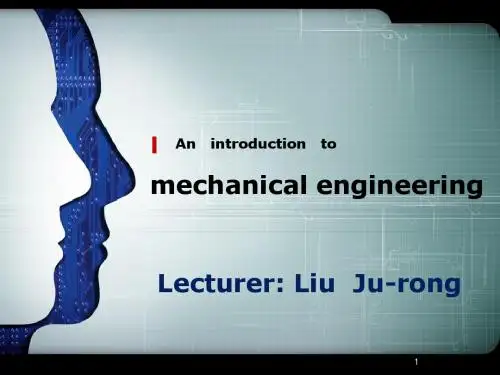
机械工程学科概论(doc 63页)机械工程学科概论姓名: XXX班级: XX-X学号: XX此课程概论总结,根据我们机械设计及制造及其自动化专业所学课程,主要选取了以下13门课程,对其内容做一个浅显的归纳。
其目的除了是对以往所学知识的一种总结和回顾,更多的则是在这个总结的过程中明确自己的能力,精确自己的定位,以确定自己未来的学习方向和发展之路。
总的来说,这门课程,从内容上说,虽比较枯燥一些,但其站在一个统筹的位置上让学生对自己所学专业有了一个整体上的认识,我想它还是有其现实意义和价值的。
也希望老师能更多的更多的发掘这门课程的内在潜力,让学生更加的易于接受和学习!虽然之前不怎么明白这门课程的意义,但在真正自己总结的过程中却慢慢体会到了这门课程开设的价值所在。
最后,感谢老师在这一学期所做的努力!一、机械设计Part A 绪论1机械工业在现代化建设中的作用2本课程的内容、性质与任务Part B 机械设计总论1机器的组成2设计机器的一般程序3对机器的主要求4机械零件的主要失效形式5设计机械零件应满足的基本要求6机械零件的设计准则7机械零件的设计方法8机械零件设计的一般步骤9机械零件的材料及其选用10机械零件设计中的标准化11机械现代设计方法简介Part C 机械零件的强度1材料的疲劳特性2机械零件的疲劳强度计算3机械零件的抗断裂强度4机械零件的接触强度5机械零件可靠性设计简介Part D 摩擦磨损及润滑1摩擦2磨损3润滑剂、添加剂和润滑方法4流体润滑原理简介Part E 螺纹连接和螺纹传动1螺纹2螺纹连接的类型和标准连接件3螺纹连接的预紧4螺纹连接的防松5螺栓组连接的设计6螺纹连接的强度计算7螺纹连接件的材料及许用应力8提高螺纹连接强度的措施9螺旋传动Part F 键、花键、无键连接和销连接1键连接2花键连接3无键连接4销连接Part G 铆接、焊接、胶接和过盈连接1铆接2焊接3胶接4过盈连接Part H 带传动1概述2带传动工作情况的分析3普通V带传动的设计计算4V带轮的设计5V带传动的张紧、安装与防护Part I 链传动1链传动的特点及应用2传动链的结构特点3滚子链链轮的结构和材料4链传动的工作情况分析5滚子链传动的设计计算6链传动的布置、张紧、润滑与防护Part J 齿轮传动1概述2齿轮传动的失效形式及设计准则3齿轮的材料及其选择原则4齿轮传的计算载荷5标准值齿圆柱齿轮传动的强度计算6齿轮传动的设计参数、许用应力与精度选择7标准斜齿圆柱齿轮传动的强度计算8标准锥齿轮传动的强度计算9变位齿轮传动强度计算概述10齿轮的结构设计11齿轮传动的润滑12圆弧齿圆柱轮传动简介Part K 蜗杆传动1蜗杆传动的类型2普通蜗杆传动的主要参数及几何尺寸计算3普通圆柱蜗杆传动承载能力计算4圆弧圆柱蜗杆传动设计计算5普通圆柱蜗杆传动的效率、润滑及热平衡计算6圆柱蜗杆和蜗轮的结构设计Part L 滑动轴承1概述2滑动轴承的主要结构形式3滑动轴承的失效形式及常用材料4轴瓦结构5滑动轴承润滑剂的选用6不完全液体润滑滑动轴承设计计算7液体动力润滑径向滑动轴承设计计算8其他形式滑动轴承简介Part M 滚动轴承1概述2滚动轴承的主要类型及其代号3滚动轴承类型的选择4滚动轴承的工作情况5滚动轴承尺寸的选择6轴承装置的设计7其他Part N 联轴器和离合器1联轴器的种类和特性2联轴器的选择3离合器4安全联轴器和安全离合器5特殊功用及特殊结构的联轴器和离合器Part O 轴1概述2轴的结构设计3轴的计算Part P 弹簧1概述2圆柱螺旋弹簧的结构、制造、材料及许用应力3圆柱螺旋压缩(拉伸)弹簧的设计4圆柱螺旋扭转弹簧的设计计算Part Q 机座和箱体简介1概述2机座和箱体的截面形状及肋板布置3机座和箱体设计概要Part R 减速器和变速器1减速器2变速器3摩擦轮传动简介二、机械原理Part A 绪论1本课程研究的对象及内容2学习本课程的目的3如何进行本课程的学习4机械原理学科发展现状简介Part B 机构的结构分析1机构结构分析的内容及目的2机构的组成3机构运动简图4机构具有确定运动的条件5机构自由度的计算6计算平面机构自由度时应注意的事项7平面机构的组成原理、结构分类及结构分析8机构结构的型综合及其设计Part C 平面机构的运动分析1机构运动分析的任务、目的和方法2用速度瞬心法作机构的速度分析3用矢量方程图解法作机构的速度及加速度分析4综合运用瞬心法和矢量方程图解法对复杂机构进行速度分析5用解析法作机构的运动分析Part D 平面机构的力分析1机构力分析的任务、目的和方法2构件惯性力的确定3运动副中摩擦力的确定4不考虑摩擦时机构的力分析5考虑摩擦时机构的受力分析Part E 机械的效率和自锁1机械的效率2机械的自锁Part F 机械的平衡1机械平衡的目的及内容2刚性转子的平衡计算3刚性转子的平衡实验4转子的许用不平衡量5平面机构的平衡Part G 机械的运转及其速度波动的调节1概述2机械的运动方程式3机械运动方程式的求解4稳定运转状态下机械的周期性速度波动及其调节5机械的非周期性速度波动及其调节6考虑构件弹性时的机械动力学简介Part H 平面连杆机构及其设计1连杆机构及其传动特点2平面四杆机构的类型和应用3平面四杆机构的基本知识4平面四杆机构的设计5多杆机构Part I 凸轮机构及其设计1凸轮机构的应用和分类2推杆的运动规律3凸轮轮廓曲线的设计4凸轮机构基本尺寸的确定5高速凸轮机构简介Part J 齿轮机构及其设计1齿轮机构的特点及类型2齿轮的齿廓曲线3渐开线齿廓及其啮合特点4渐开线标准齿轮的基本参数和几何尺寸5渐开线直齿圆柱齿轮的啮合传动6渐开线齿廓的切制原理与根切现象7渐开线变位齿轮简介8斜齿圆柱齿轮传动9直齿锥齿轮传动10蜗杆传动11其他齿轮传动简介12齿轮机构动力学简介Part K 齿轮系及其设计1齿轮系及其分类2定轴轮系的传动比3周转轮系的传动比4复合轮系的传动比5轮系的功用6行星轮系的效率7行星轮系的类型选择及设计的基本知识8其他新型行星齿轮传动简介Part L 其他常用机构1棘轮机构2槽轮机构3擒纵机构4凸轮式间歇运动机构5不完全齿轮机构6星轮机构7非圆齿轮机构8螺旋机构9万向铰链机构10组合机构11含有某些特殊元器件的广义机构Part M 工业机器人机构及其设计1概述2工业机器人操作机的分类及主要技术指标3机器人操作机的运动分析4机器人操作机的静力和动力分析5工业机器人操作机机构的设计Part N 机械系统的方案设计1概述2机械工作原理的拟定3执行构件的运动设计和原动机的选择4机构的选型和变异5机构的组合6机械系统方案的拟定7机械系统方案拟定举例8现代机械系统发展情况简介三、画法几何Part A 绪论1.1画法几何的任务及学习方法1.2投影法的基本概念1.3工程上常用的投影图概述Part B 点1.1两投影面体系中点的投影1.2三投影面体系中点的投影Part C 直线1.1直线的投影1.2特殊位置的直线1.3一般位置线段的实长及其与投影面的夹角1.4属于直线的点1.5直线的迹点1.6两直线的相对位置1.7直角投影定理Part D 平面1.1平面的表示法1.2特殊位置的平面1.3属于平面的点和直线Part E 直线与平面的相对位置、两平面的相对位置1.1直线与平面平行、两平面平行1.2直线与平面的交点、两平面的交线1.3直线与平面垂直、两平面垂直Part F 投影变换1.1概述1.2换面法1.3旋转法——绕投影面垂直轴旋转1.4旋转法——绕投影面平行轴旋转1.5综合性问题解法举例Part G 基本立体1.1平面立体1.2常见回转体1.3同轴回转体1.4拉伸体Part H 平面与立体相交、直线与立体相交1.1平面与立体相交1.2直线与立体相交Part I 两立体相交1.1两平面立体相贯1.2平面立体与曲面立体相贯1.3两曲面立体相贯1.4两立体相交的计算机造型Part J 曲线1.1曲线概述1.2规则曲线1.3不规则曲线Part K 曲面1.1曲面概述1.2规则曲面1.3曲面的切平面1.4不规则曲面1.5常见的计算机曲面建模方法Part L 立体的表面展开1.1平面立体的表面展开1.2曲面立体表面——可展曲面的展开1.3曲面立体表面——不可展曲面的近似展开1.4变形接头的展开1.5展开图的CAD技术Part M 轴测投影1.1概述1.2正轴测图1.3斜轴测图Part N 透视投影1.1透视投影的基本知识和术语1.2点的透视投影1.3直线的透视投影1.4平面立体的透视四、机械制图Part A 制图的基本知识和基本技能1国家标准《技术制图》和《机械制图》的有关规定2尺规绘图3徒手绘图Part B 计算机造型和绘图基础1 AutoCAD 2006绘图基础2AutoCAD 2006工程图的绘制3Inventor 9软件简介4Inventor草图的创建5Inventor特征的创建6Inventor部件装配基础7Inventor工程图的创建Part C 组合体1组合体的视图2组合体的构形和分析方法3画组合体视图的方法和步骤4看组合体视图的方法和步骤5标注组合体尺寸的方法6组合体的构形设计Part D 轴测图1轴测图的基础知识2正等轴测图的画法3正等轴测草图的画法4轴测剖视图的画法5轴测图的尺寸标注6斜二轴测图的画法7轴测图的选择Part E 机件的图样画法1视图2剖视图3断面图4其他规定画法和简化画法5机件各种表示法综合运用Part F 零件图1零件图的内容2零件的构形设计3螺纹4零件表达方案的选择5零件图中尺寸的合理标注6零件图上的技术要求7看零件图的方法和步骤8典型零件图例分析9零件的测绘Part G 标准件与常用件1螺纹紧固件2键3销4滚动轴承5弹簧6齿轮7花键8焊接件Part H 装配图1装配图的内容2装配图的图样画法3装配图中的尺寸标注和技术要求4装配图的零件序号及明细栏、标题栏5装配体构形设计的合理性6部件测绘7画装配图的方法和步骤8看装配图的方法和步骤9由装配图拆画零件图五、液压与气压传动Part A 液压传动基础知识1液压传动工作介质2液体静力学3液体动力学4定常管流的压力损失计算5孔口和缝隙流动6空穴现象7液压冲击Part B 液压动力元件1液压泵概述2齿轮泵3叶片泵4柱塞泵5液压泵的噪声6液压泵的选用Part C 液压执行元件1液压马达2液压缸Part D 液压控制元件1概述2方向控制阀3压力控制阀5叠加式液压阀6二通插装阀7液压阀的连接Part E 液压辅助元件1管路和管接头2油箱3过滤器4密封装置5蓄能器Part F 液压基本回路1压力控制回路2速度控制回路3多缸工作控制回路4其他回路Part G 典型液压传动系统1组合机床动力滑台液压系统2万能外圆磨床液压系统3液压压力机液压系统4装卸堆码机液压系统Part H 液压伺服和电液比例控制技术1液压伺服控制2电液比例控制3计算机电液控制技术Part I 液压系统的设计与计算1明确设计要求、进行工况分析2拟定液压系统原理图3液压元件的计算和选择4液压系统的性能验算5绘制工作图和编制技术文件6液压系统设计计算举例Part J 气压传动基础知识1空气的物理性质2气体状态方程3逻辑运算简介Part K 源装置及气动辅助元件1气源装置2气源净化装置3其他辅助元件4供气系统的管道设计Part L 气动执行元件1气缸2气动马达Part M 气动控制元件2压力控制阀3流量控制阀4气动逻辑元件5气动比例阀及气动伺服阀Part N 气动基本回路1换向回路2速度控制回路3压力控制回路4气液联动回路5计数回路6延时回路7安全保护和操作回路8顺序动作回路Part O 气动程序系统及其设计1行程程序控制系统的设计步骤2多缸单往复行程程序回路设计3多缸多往复行程程序回路设计Part P 气压传动系统实例1气动机械手气压传动系统2气动钻床气压传动系统3气液动力滑台气压传动系统4工件夹紧气压传动系统六、机械工程控制基础Part A 绪论1机械工程控制论的研究对象与任务2系统及其模型3反馈4系统的分类及对控制系统的基本要求5机械制造的发展与控制理论的应用6控制理论发展的简单回顾7设计示例:数控直线运动工作台位置控制系统8本课程的特点与学习方法Part B 系统的数学模型1系统的微分方程2系统的传递函数3系统的传递函数方框图及其简化4考虑扰动的反馈控制系统的传递函数5相似原理6系统的状态空间模型7数学模型的MATLAB描述8设计示例:数控直线运动工作台位置控制系统Part C 系统的时间响应分析1时间响应及其组成2典型输入信号3一阶系统4二阶系统5高阶系统6系统误差分析与计算7δ函数在时间响应中的作用8利用MATLAB分析时间响应9设计示例:数控直线运动工作台位置控制系统Part D 系统的频率特性分析1频率特性概述2频率特性的图示方法3频率特性的特征量4最小相位系统与非最小相位系统5利用MATLAB分析频率特性6设计示例:数控直线运动工作台位置控制系统Part E 系统的稳定性1系统稳定性的初步概念2 Routh稳定判据3 Nyquist稳定判据4 Bode稳定判据5系统的相对稳定性6利用MATLAB分析系统的稳定性7设计示例:数控直线运动工作台位置控制系统Part F 系统的性能指标与校正1系统的性能指标2系统的校正3串联校正4PID校正5反馈校正6顺馈校正7利用MATLAB设计系统校正8设计示例:数控直线运动工作台位置控制系统9关于系统校正的一点讨论Part G 非线性系统初步Part H 线性离散系统初步Part I 系统辨识初步七、材料力学Part A 绪论1 材料力学的任务2 变形固体的基本假设3 外力及其分类4 内力、截面法和应力的概念5 变形与应变6 杆件变形的基本形式Part B 拉伸、压缩与剪切1 轴向拉伸与压缩的概念和实例2 直杆轴向拉伸或压缩时横截面上的内力和应力3 直杆轴向拉伸或压缩时斜截面上的应力4 材料拉伸时的力学性能5 材料压缩时的力学性能6 温度和时间对材料力学性能的影响7 失效、安全因数和强度计算8 杆件轴向拉伸或压缩时的变形9 轴向拉伸或压缩的应变能10 拉伸、压缩的超静定问题11 温度应力和装配应力12 应力集中的概念13 剪切和挤压的实用计算Part C 扭转1 扭转的概念和实例2 外力偶矩的计算扭矩和扭矩图3 纯剪切4 圆轴扭转时的应力5 圆轴扭转时的变形6 圆柱形密圈螺旋弹簧的应力和变形7 非圆截面杆扭转的概述8 薄壁杆件的自由扭转Part D 弯曲内力1 弯曲的概念和实例2 受弯杆件的简化3 剪力和弯矩4 剪力方程和弯矩方程剪力图和弯矩图5 载荷集度、剪力和弯矩间的关系6 平面曲杆的弯曲内力Part E 弯曲应力1 纯弯曲2 纯弯曲时的正应力3 横力弯曲时的正应力4 弯曲切应力5 关于弯曲理论的基本假设6 提高弯曲强度的措施Part F 弯曲变形1 工程中的弯曲变形问题2 挠曲线的微分方程3 用积分法求弯曲变形4 用叠加法求弯曲变形5 简单超静定梁6 减小弯曲变形的一些措施Part G 应力和应变分析、强度理论1 应力状态概述2 二向和三向应力状态的实例3 二向应力状态分析———解析法4 二向应力状态分析———图解法5 三向应力状态6 位移与应变分量7 平面应变状态分析8 广义胡克定律9 复杂应力状态下的应变能密度10 强度理论概述11 四种常用强度理论12 莫尔强度理论13 构件含裂纹时的断裂准则Part H 组合变形1 组合变形和叠加原理2 拉伸或压缩与弯曲的组合3 偏心压缩和截面核心4 扭转与弯曲的组合5 组合变形的普遍情况Part I 压杆稳定1 压杆稳定的概念2 两端铰支细长压杆的临界压力3 其他支座条件下细长压杆的临界压力4 欧拉公式的适用范围经验公式5 压杆的稳定校核6 提高压杆稳定性的措施8纵横弯曲的概念附录Ⅰ 平面图形的几何性质Ⅰ.1 静矩和形心Ⅰ.2 惯性矩和惯性半径Ⅰ.3 惯性积Ⅰ.4 平行移轴公式Ⅰ.5 转轴公式主惯性轴Part J 动载荷1 概述2 用动静法求应力和变形3 受迫振动的应力计算4 杆件受冲击时的应力和变形5 冲击韧性Part K 交变应力1 交变应力与疲劳失效2 交变应力的循环特征、应力幅和平均应力3 持久极限4 影响持久极限的因素5 对称循环下构件的疲劳强度计算6 持久极限曲线7 不对称循环下构件的疲劳强度计算8 弯扭组合交变应力的强度计算9 变幅交变应力10 提高构件疲劳强度的措施Part L 弯曲的几个补充问题1 非对称弯曲2 开口薄壁杆件的切应力弯曲中心Part M 能量方法1 概述2 杆件应变能的计算3 应变能的普遍表达式4 互等定理5 卡氏定理6 虚功原理7 单位载荷法莫尔积分8 计算莫尔积分的图乘法Part N 超静定结构1 超静定结构概述2 用力法解超静定结构3 对称及反对称性质的利用4 连续粱及三弯矩方程忌考题Part O 平面曲杆1 概述2 曲杆纯弯曲时的正应力3 中性层曲率半径的确定4 曲杆的强度计算5 曲杆的变形计算Part P 厚壁圆筒和旋转圆盘1 概述2 厚壁圆筒3 组合厚壁圆筒4 等厚旋转圆盘Part Q 矩阵位移法1 概述2 轴向拉伸(压缩)杆件的刚度方程3 受扭杆件的刚度方程4 受弯杆件的刚度方程5 单元的中间载荷6 组合变形杆件的刚度方程7 受拉(压)杆件的坐标变换8 受弯杆件的坐标变换Part R 杆件的塑性变形1 概述2 金属材料的塑性性能3 拉伸和压缩杆系的塑性分析4 圆轴的塑性扭转5 塑性弯曲和塑性铰6 梁的塑性分析7 残余应力的概念8 厚壁圆筒的塑性变形八、理论力学Part A 力系作用量1主矢、汇交力系合力2力矩、主矩3力系作用量、等效、平衡4力偶5力系简化6重心,平行分布力Part B 物体的受力分析1约束、约束力和主动力2常见约束及其约束力3受力分析与受力图Part C 平衡力系作用下物体的受力1力系平衡条件和平衡方程2平面力系平衡方程及应用3简单物体系的平衡问题4静定和超静定问题的概念5平面简单桁架6摩擦7滚动阻力偶8空间力系平衡方程的应用Part D 点的运动学1矢量法2笛卡儿坐标法3自然法Part E 刚体的基本运动1刚体的平移2刚体的定轴转动Part F 刚体的平面运动1概述2刚体平面运动的解析法3刚体平面运动的分解4速度分析5加速度分析Part G 点的复合运动1概述2速度、加速度合成定理3科氏加速度4运动学综合题Part H 质点动力学基本方程1 惯性参考系中的质点动力学基本方程(质点运动微分方程)3非惯性参考系中的质点动力学基本方程Part I 动量定理1.动力学普遍定理的意义2.质点与质点系动量定理3.质心运动定理4.动量定理应用举例Part J 动量矩定理1质点系运动量的主矢、主矩2矩心为定点的动量矩定理3刚体定轴转动动力学方程4转动惯量5相对运动动量矩定理6对质心的动量矩定理,刚体平面运动动力学方程Part K 动能定理1质点和质点系动能定理2质点系动能3力的功4约束力的功,内力的功,理想约束5势能,机械能守恒6功率7动能定理的应用8动力学普遍定理综合题Part L 动静法1质点和质点系动静法2惯性力系的简化3动静法的应用4轴承动约束力,动平衡Part M 碰撞1碰撞的基本概念2应用于碰撞问题的动量和动量矩定理3恢复因数4质点碰撞的动能损失5撞击中心Part N 虚位移原理1约束、虚位移、虚功、理想约束2虚位移原理3广义坐标与自由度4广义力与平衡条件Part O 拉格朗日方程1达朗贝尔原理2动力学普遍方程(达朗贝尔一拉格朗日方程)3拉格朗日方程4拉格朗日方程的初积分Part P 振动1单自由度无阻尼自由振动2能量法3单自由度有阻尼自由振动4单自由度无阻尼受迫振动5单自由度有阻尼受迫振动九、工程流体力学Part A 绪论1流体力学的研究内容和研究方法2流体力学在工程技术中的地位3流体力学在教学计划中的地位4工程流体力学内容简介Part B 流体及其物理性质1流体的定义和特征2流体作为连续介质的假设3作用在流体上的力表面力质量力4流体的密度5流体的压缩性和膨胀性6流体的黏性7液体的表面性质Part C 流体静力学1流体静压强及其特性2流体平衡方程式3重力场中流体的平衡帕斯卡原理4液柱式测压计5液体的相对平衡6静止液体作用在平面上的总压力7静止液体作用在曲面上的总压力8静止液体作用在潜体和浮体上的浮力阿基米德原理Part D 流体运动学和流体动力学基础1流体运动的描述方法2流动的分类3迹线流线4流管流束流量水力半径5系统控制体输运公式6连续方程7动量方程动量矩方程8能量方程9伯努利方程及其应用10沿流线主法线方向压强和速度的变化11黏性流体总流的伯努利方程Part E 相似原理和量纲分析1流动的力学相似2动力相似准则3流动相似条件4近似的模型试验5量纲分析法Part F 管内流动和水力计算液体出流1管内流动的能量损失2黏性流体的两种流动状态3管道进口段黏性流体的流动4圆管中流体的层流流动5黏性流体的紊流流动6沿程损失的实验研究7非圆形管道沿程损失的计算8局部损失9各类管流的水力计算10几种常用的技术装置11液体出流12水击现象13气穴和气蚀简介Part G 气体的一维流动1微弱压强波的一维传播声速马赫数2气流的特定状态和参考速度速度系数3正激波4变截面管流5等截面摩擦管流6等截面换热管流Part H 理想流体的有旋流动和无旋流动1微分形式的连续方程2流体微团运动分解3理想流体运动方程定解条件4理想流体运动方程的积分5涡缱涡管涡市渑诵鲁6速度环量斯托克斯定理7汤姆孙定理亥姆霍兹定理8平面涡流9速度势流函数流网10几种简单的平面势流11简单平面势流的叠加12均匀等速流绕过圆柱体的平面流动13均匀等速流绕过圆柱体有环流的平面流动14叶栅的库塔一儒可夫斯基公式15库塔条件Part I 黏性流体绕过物体的流动1黏性流体微分形式的运动方程(纳维—斯托克斯方程)2不可压缩黏性流体的层流流动3边界层的基本概念4层流边界层微分方程5边界层动量积分关系式6边界层的位移厚度和动量损失厚度7平板层流边界层的近似计算8平板紊流边界层的近似计算9平板混合边界层的近似计算10曲面边界层的分离现象11绕过圆柱体的流动卡门涡街12物体阻力自由沉降速度13自由淹没射流Part J 气体的二维流动1微弱压强波在空间的传播马赫锥2微弱压强波气流折转角3斜激波4激波的反射和相交5激波与边界层的相互干扰十、互换性与技术测量Part A 绪论1 互换性与公差1.1互换性与公差的概念和作用1.2互换性的2 标准化与优先数系2.1标准化2.2优先数系3 几何量检测概述3.1几何量检测的重要性3.2几何量检测在我国的发展4 本课程的任务Part B 几何量测量基础1概述1.1被测对象1.2计量单位1.3测量方法1.4测量精度。